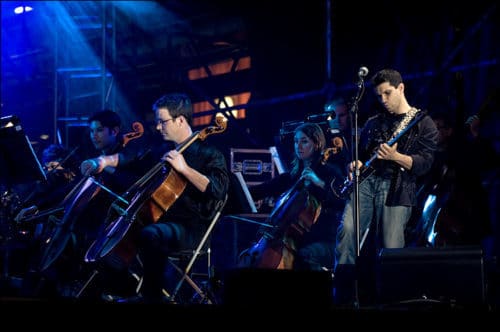
Video Games Live performing at a concert in Toronto in 2008.
Photo courtesy of Sam Javanrouh (Flickr)
A few months ago, I had the chance to experience Video Games Live – a masterful symphonic suite of classic video game music across multiple decades. This concept was unfathomable for several of my relatives, who couldn’t comprehend why anyone would want to listen to the Super Mario Brothers theme on repeat for two hours.
It came to my attention that, unless someone took the time to actively listen to the progression of video game music, they would still think it’s nothing more than “bleeps and bloops.”
In the 1980’s, video game music consisted of chiptunes, 8-bit anthems composed electronically through synthesizer. Gaming composers could create impressive tunes for the time, and some tracks, such as the iconic theme to The Legend of Zelda, are still instantly recognizable today. Music could only take up so much space on a cartridge, so composers had to finely craft each melody to make it stand out. There wasn’t much depth behind these 8-bit tracks, but the simplistic nature of the melodies allowed them to nest within your head well after turning off the console.
Despite the popularity of 8-bit music among gamers, chiptunes aren’t exactly cherished among those out of the retro gaming loop. Luckily, with each new generation came updated technology and vastly improved instrumentation.
When the 16 and 64-bit era arrived, video game music was already well beyond the limitations of the past. Although some games would still utilize 8-bit sound fonts for a dose of retro nostalgia, composers were now able to use fully synthesized instruments, such as pianos, harps, guitars and trumpets. Most notably, David Wise, the musical mastermind behind the Donkey Kong Country soundtrack, revolutionized the idea of a “video game soundtrack.”
Wise found his unique style through the use of percussion, nature sound effects and even elements of ambient music in his tracks. His music became so praised among gamers and critics alike, an official soundtrack was released just a year after the game’s initial launch. This was perhaps the first instance of a video game soundtrack steadily finding mainstream attention and success.
Today, video game music has evolved even further, with fully-orchestrated soundtracks becoming the norm for titles such as 2012’s award winning indie hit, Journey. Back in 2006, MTV presented a video game music segment during their annual VMA’s, honoring The Elder Scrolls IV: Oblivion with an award for best gaming soundtrack of the year. Even Nintendo’s famous mustached mascot received a surprising orchestral soundtrack, with the 2007 release of Super Mario Galaxy.
Video games are no longer confined to their humble, pixilated beginnings. With each new generation, game composers must adapt to technological upgrades. The gorgeous, hi-resolution landscapes of modern titles would feel utterly lifeless without an accompanying musical score. The array of emotion that game composers can create is truly a testament to how far video games have come throughout the years.


